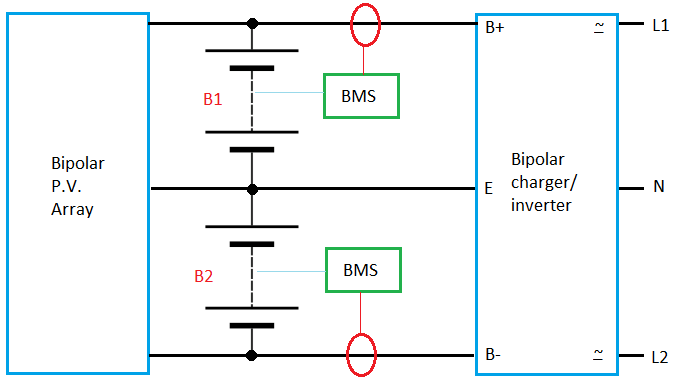White Paper - Split (center-tap) batteries
Used in conjunction with bipolar charger / inverters or bipolar PV arrays

A bipolar charger / inverter uses 2 batteries in series, which appear as a split battery with a center tap.
That is also true of a bipolar PV array.
The levels of current of the two batteries are very close (due to the inherent symmetry of the bipolar charger / inverter), but they will never be exactly the same.
Because each battery has its own level of current, each battery has its own SoC level, and each battery requires its own BMS, power switch and current sensor.
It would be a mistake to attempt to use a single BMS for both batteries, as it would not be able to manage two batteries with two different currents, and two different SoC levels.
Due to the difference in the two current levels, the SoC levels of the two batteries will drift apart over time,
at a rate that depends on how well balanced the bipolar inverter is.
When used in conjunction with a bipolar P.V. array, the currents will be significantly different, due to variations in the panel's efficiencies and due to uneven insolation.
There are various approaches to balance the two batteries, each of which has drawbacks:
| Name
| Description
| Drawbacks
|
| BMS balance
| Allow each BMS to balance its battery to the same SoC level:
typically, that means allowing the inverter to charge both batteries fully and leave them there for a long time,
while each BMS balances its own battery at 100 % SoC
| The battery will be out of commission during this balancing time
|
| Dedicated charger
| Use a separate charger, to recharge whichever battery's SoC is lower
| Requires logic to read the SoC levels reported by the 2 BMSs, and decide which battery needs extra charge
|
| DC-DC converter between batteries
| Add a DC-DC converter, to transfer charge from the battery with higher SoC to the one with lower SoC
| Requires either a bidirectional DC-DC converter, or contactors to change the direction of the DC-DC converter
|
| DC-DC converter to external load
| Add a DC-DC converter, to power an external load, switching between batteries at a duty cycle of about 50 % to balance the load,
but favoring whichever battery has the higher SoC at the given time
| Rather complex; during switching, there is no power output from the DC-DC converter
|
Voltage-based
inverter-balance
| Design the bipolar inverter so that it can be made to draw more current from one battery than the other,
and make it draw more power from the battery whose voltage is higher, or give more power to the battery whose voltage is lower
| The voltage of Li-ion batteries is quite flat in the region of interest for power quality applications (around 50 % SoC),
making voltage a poor indication of battery balance; additionally, battery voltage is affected by current and internal resistance:
a battery's low voltage may be more due to high resistance than low SoC, leading to balancing in the wrong direction
|
BMS-based
inverter-balance
| Same as above, but base the desision on the SoC reported by the 2 BMSs
| Requires specialized software to control the charger / inverter
|
Ideally, the last approach would be best, if the manufacturer of the bipolar charger / inverter would incorporate support for SoC information from 2 BMSs.
Otherwise, the dedicated charger is probably the most practical solution.
Davide Andrea, Elithion, 6/6/17
 Li-Ion BMS
Li-Ion BMS

